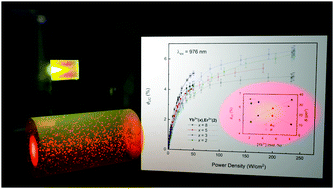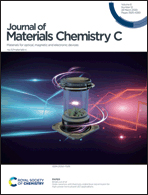Upconversion properties of SrF2:Yb3+,Er3+ single crystals†
Abstract
Synthesis of new upconversion (UC) materials that can convert near-infrared excitation light into visible emission light with high efficiency has crucial importance for energy and bio-applications. Herein, SrF2 single crystals with a doping concentration of 2 mol% Er3+ and 2–8 mol% Yb3+ were synthesized and the optical properties were studied. The absorption cross-section of the different doping ions was calculated. To identify the most efficient and brightest material absolute excitation power dependent UC photoluminescence quantum yields (ϕUC) and brightness values were determined. In addition, excitation characteristics and luminescence lifetimes were analysed to understand the changes in population pathways and possible quenching mechanisms. A dominant two-photon population behaviour of the red and green emission bands was observed for all investigated doping concentrations of Yb3+ and Er3+. The ϕUC value of 6.5% measured using 230 W cm−2 of 976 nm excitation for SrF2 crystal co-doped with 2 mol% Er3+ and 3 mol% Yb3+. These findings broaden the scope of efficient UC materials apart from the record UC material β-NaYF4:Yb3+, Er3+ and provide benchmark values for cubic-phase and especially SrF2- nano and micrometer sized materials.



 Please wait while we load your content...
Please wait while we load your content...